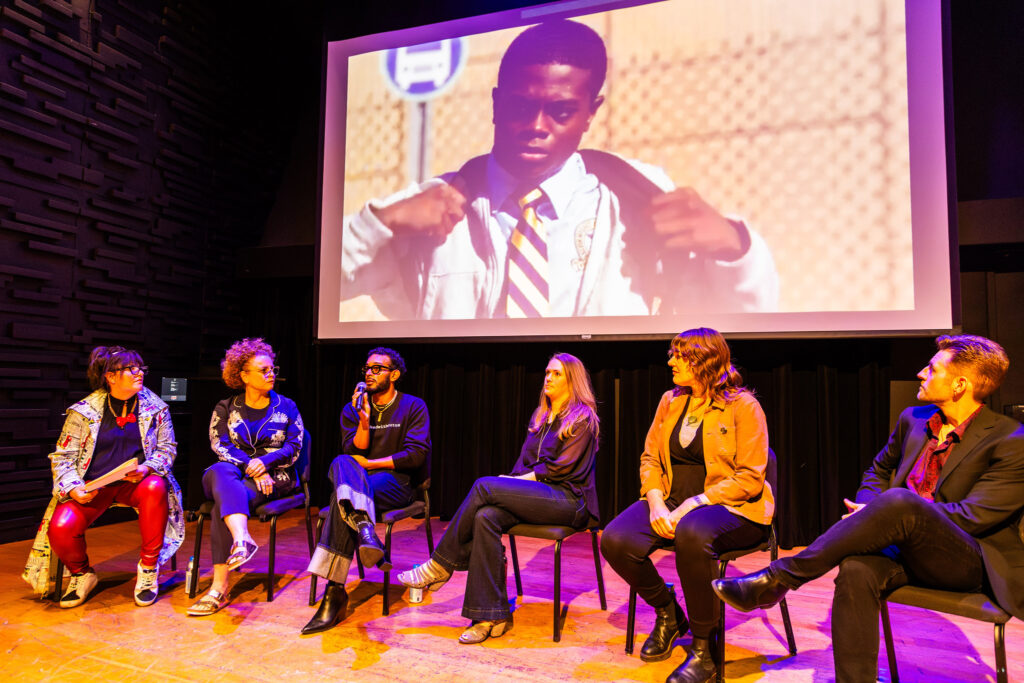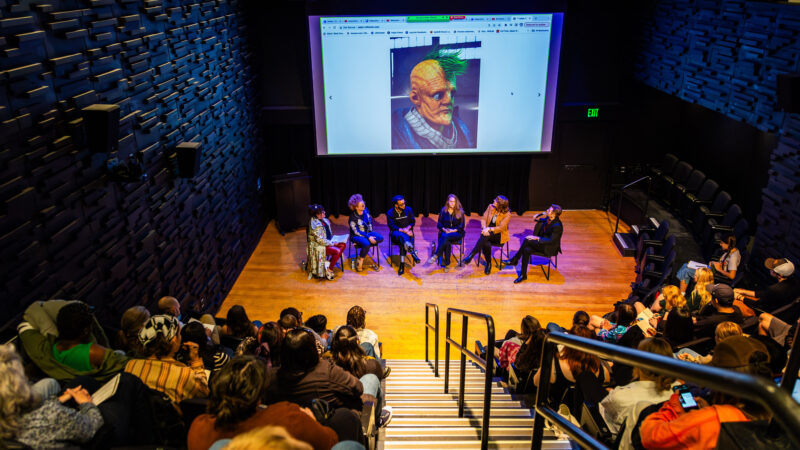Amid beautiful, terrifying and thrilling images of aliens, mutants, period gangsters and elegant princesses, six artists at the top of their fields in costume design, makeup and visual effects gathered to discuss their industry and craft at Character by Design, the academic year’s second Multihyphenate Masterclass.
Led by faculty member and costume designer Ann Closs-Farley, the workshop was highly visual, featuring lush and striking images of the artists’ work as they discussed their processes both for creating it, and for breaking into the eclectic world of costume and makeup design in the first place.
One theme emerged during the first half of the workshop: in such a multifaceted and varied field, everybody’s journey into design is different, and there is no one, fixed way to break into a career in costume, makeup or visual effects.

“When I moved to L.A. and got started, I moved during a different strike,” makeup artist Cristina Waltz said. Waltz, who recently received her second Emmy nomination for her work on The Mandalorian, has designed makeup and prosthetics for films and shows like Dungeons and Dragons: Honor Among Thieves, Bright and Ahsoka. “I wasn’t in the union. I was just starting out. What I did was go on Craigslist to find a place to live, and I typed in ‘makeup artist.’ I found any listing with a make-up artist renting a room. I ended up moving in with a fashion designer and a scenic painter. That was my start in networking.”
Waltz, who enjoys working with tactile effects and textures, began studying physical prosthetics at a time when conventional wisdom in the industry was that everything would become more digital. Bucking the trend, Waltz took a six-month course and moved to Toronto to learn prosthetics, then moved back to L.A.
“I traveled a journey that kept going,” Waltz said. “From theatre, I started doing short films and student films here. I did a lot of USC student films when I first moved to L.A. I kept meeting the right people.”
Costume designer Audrey Fisher, whose work includes costuming for Barry, True Blood and, most recently, Love and Death, started out thinking she wanted to be a dramaturg. After moving to New York, she began making hats, and a director friend asked her to costume a short film.
“I had $1000,” she laughed. “I swear I think those are some of the most creative costumes I ever made.”

Eternally curious artists
Other guest artists onstage included USC School of Dramatic Arts (SDA) alumna and two-time Emmy nominee Sara Fox (BFA ’10), whose costume design work includes Air, The Mandalorian and High School Musical: The Series, costume designer and fashion stylist Fernando A. Rodriguez (Moonlight, The Florida Project) and digital artist Adam Milan Milicevic of the Oscar-nominated, Emmy-winning studio Legacy Effects (Guardians of the Galaxy Volume 3, Dungeons and Dragons: Honor Among Thieves, Avatar: The Way of Water). Each of the artists went through a stunning visual presentation of their work for stage and screen and discussed their individual processes for coming up with visual designs that help tell the story.
“We take it down to every micro-detail,” Milicevic explained, describing his process for creating digital characters. “I always try to picture something that I’d want to see on film or on screen, first and foremost.”
“For me, I like to clean the space around me,” Rodriguez said. “I like to clear my mind before I start reading the script so that I can explore if it’s emotion-driven or excitement-driven. Once I start reading and processing it, I’ll take a day to start pulling references, images, start thinking about palettes, textures. I’ll start thinking about personality: What music would the character listen to, what food do they like, who would they hang out with?”
The artists also stressed the importance of collaborating with other creatives, noting that in a visual field like costume and makeup design, one must work with a team of creatives, writers and the actors themselves to successfully bring a character to life.
“As a costume designer, there’s a lot of psychology involved, working with actors, especially if they’re super collaborative,” Fox said. “They live and breathe that character, so there’s a lot of work where you try to reach their goals in terms of character development, and from an aesthetic standpoint, too.”
Rodriguez described the process of presenting a costume idea to an actor for the first time.
“For me, noes mean a lot more than yesses, because now I’m learning the person,” he said. “If there ever is a point that is going to change the narrative, I try to understand the why. You’re wearing it, not me. I’m just a vessel. I’m just here to help you tap into the character. I try to respect their craft.”

In the second half of the workshop, the artists went on to discuss a variety of subjects, including working with strong personalities, what to do if an actor or director has a different vision for the work and how to survive financially during the early years of a career in costume and makeup design. The artists also discussed another shared experience: the long hours and potential for burnout in the middle of important projects.
“I know this business is feast or famine,” Fox said. “We’ve seen that in the last five years in particular. When I’m on and working, I’m working 24/7. In the last four or five years when I’ve taken a project, I didn’t used to break for lunch. I would just sit at my desk and scarf food down.”
Fox explains that in recent years she has focused more on self-care.
“Know that it’s okay to turn down some jobs because you need that mental break,” she said. “Finding that balance is so hard in the moment. It’s so important to take care of yourself.”
Waltz agreed.
“I look back on it, and I wish I had taken a little more of a breather,” she said. “When I started to say no to things from time to time, as my career got going, I started getting the best jobs I’d ever had. Suddenly I was doing things that were much bigger, things that had a franchise behind them, so I needed to be present.”
The artists held a question-and-answer session with the students and alumni in attendance, sharing their experience and wisdom with young artists interested in adding costume design, makeup and visual effects to their creative palette. Professor Closs-Farley encouraged students to consider work in such a creatively fulfilling and ever-changing field.
“That’s why I love this group so much,” she said. “These are eternally curious artists who constantly find a way to push the envelope with their work and really make these stories come to life. There are so many different ways to be an artist in our field.”
